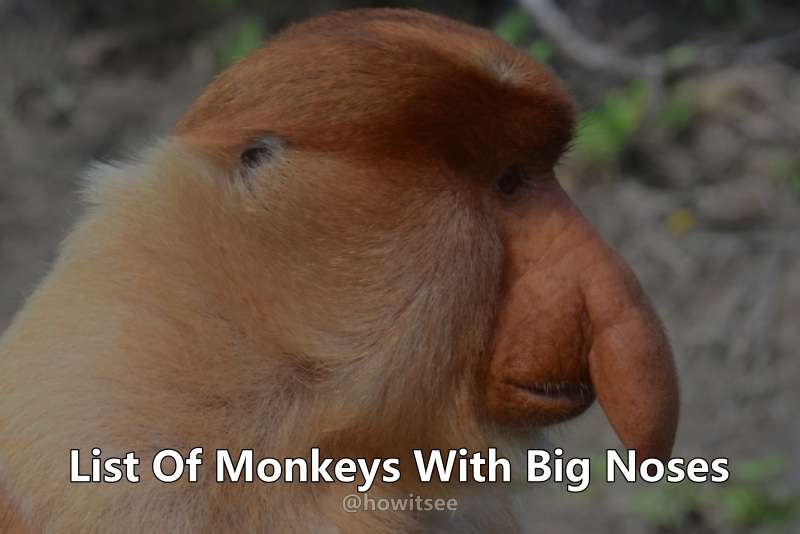Monkeys, with their intelligence, social behavior, and unique physical characteristics, are among the most fascinating creatures on the planet.
Some monkey species are distinguished by their large noses, which play an important role in their survival and communication. This article will look at the top ten monkeys with big noses on the planet, as well as their habitat, diet, behavior, and some interesting facts.
From the Proboscis Monkey in Borneo, with its long, pendulous nose that can grow up to 7 inches in length, to the gelada baboon in Ethiopia, with its distinctive heart-shaped nose, each of these species stands out in the primate world.
Others use their noses to intimidate opponents or communicate with their troops. We will also look at the threats to these unique species, such as habitat loss and hunting, as well as the efforts being made to protect them. So let’s take a look at the top ten monkeys with big noses on the planet.
Which Monkey has the Longest Nose?
The Proboscis monkey has the longest nose of any monkey species (Nasalis larvatus). The Proboscis monkey is a critically endangered ape found only on the Southeast Asian island of Borneo.
The length of the male’s large, fleshy nose can reach 7 inches (18 centimeters), making it easily distinguishable. One theory suggests that the nose helps the monkey sound more appealing to potential mates, while another suggests that it serves as an aid to the monkey’s vocalizations.
Top 10 Monkeys With Big Noses On Earth
10) Golden-Handed Tamarin
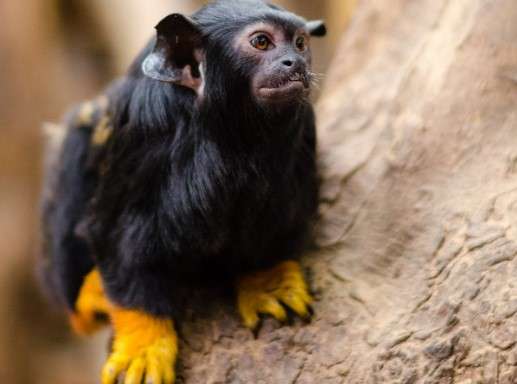
| Scientific Name | Saguinus midas |
| Size | 12-17 inches |
| Fur Color | Dark brown to black fur with bright orange fur on the hands and feet |
| Life Span | 10-16 years |
| Location | Northern Brazil, Guyana, Surinam. |
| Diet | Fruits, leaves, flowers, and insects |
The golden-handed tamarin has a body length of 20.5-28 centimeters (8.1-11.0 in), and its total length (including the tail) ranges from 31-44 centimeters (12–17 in).
Around 400-550 grams (0.88–1.21 lb). The nose length of a Golden-handed Tamarin monkey can vary, but on average, it is around 1.5 centimeters or 0.6 inches long.
The golden-handed tamarin has dark brown or black fur with bright orange hair on its hands and feet for contrast (hence the common name).
The vast, hairless ears protrude from the otherwise furry head. Marmosets, like all primates, have claws rather than nails on their hands and feet (except for the big toe). Not only that, but you can’t oppose your thumb.
9) Grey-Cheeked Mangabey
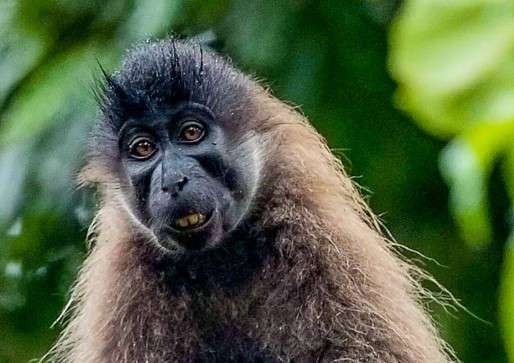
| Scientific Name | Lophocebus albigena |
| Size | 17-29 inches |
| Fur Color | Blackish Grey |
| Life Span | 36 years |
| Location | Central Africa |
| Diet | Fruits, seeds, and leaves |
The grey-cheeked mangabey is a black monkey that resembles a little, hairy baboon in general appearance. Its thick dark fur is almost black in its forest environment, with a somewhat Rufus/golden mane around the neck.
Both sexes seem the same, albeit males tend to be slightly larger than their female counterparts. The average nose length of a Grey-cheeked Mangabey is around 3-4 cm (1.2-1.6 inches). However, this can vary slightly depending on the individual and the subspecies.
The grey-cheeked mangabey can be found in various forest types throughout Central Africa. Although it is most commonly associated with marsh and primary forests, it has also been spotted in secondary forests.
Depending on the season, it primarily eats fruit, especially figs, shoots, flowers, and insects.
8) Siamang Monkey
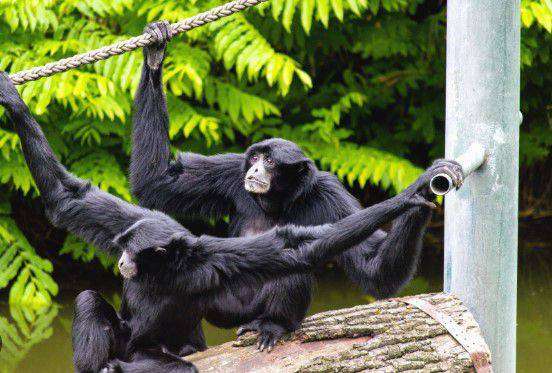
| Scientific Name | Symphalangus syndactylus |
| Size | 3.3-3.6 ft |
| Fur Color | Dark brown to black |
| Life Span | Up to 20 years |
| Location | Indonesia, Malaysia, and Thailand |
| Diet | Fruits, leaves, flowers, and insects |
Primate species Siamang Monkeys, also called black-furred gibbons, are found only in the jungles of Southeast Asia. The nose of a Siamang monkey is relatively short and flat, with wide nostrils.
Males can weigh up to 30 pounds, making them the heaviest member of the gibbon family. The nose of a Siamang Monkey is one of the species’ most recognizable characteristics.
7) De Brazza’s Monkey
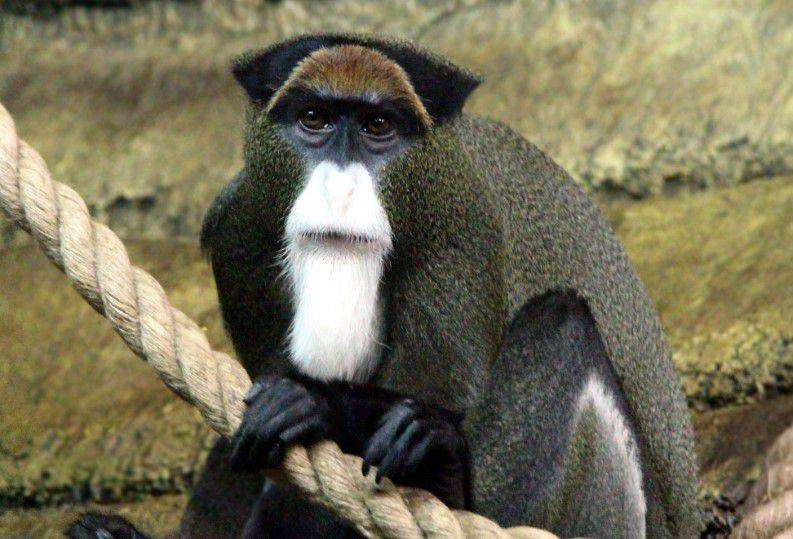
| Scientific Name | Cercopithecus neglectus |
| Size | 40-63 cm |
| Fur Color | Grey Agouti Fur with Reddish Brown Fur and Black on its limb |
| Life Span | 20-30 years |
| Location | Central Africa |
| Diet | Leaves, Flowers, Mushrooms, beetles, and worms. |
One of the most ubiquitous species of African monkeys, this guenon is the largest in its family and is also considered among the monkeys with big noses. Its orange crown and white beard set it apart from other Cercopithecus monkeys in size alone.
The elusiveness of this species means that not all of its habitats have been well studied. However, it has been observed exhibiting unusual behaviors among guenons, including pair bonding and aggressiveness.
The average nose length of a De Brazza’s Monkey is approximately 3.5 to 4 centimeters (1.4 to 1.6 inches) in males and slightly shorter in females.
Males of the De Brazza’s monkey weigh about 7 kilos, but females only weigh about 4 kilograms, making it the most sexually dimorphic guenon species.
The adult agouti has reddish-brown fur on its back, black hair on its limbs and tail, and a white rump. Men and women alike have cheek pouches to store food for later consumption.
6) Colobus Monkey
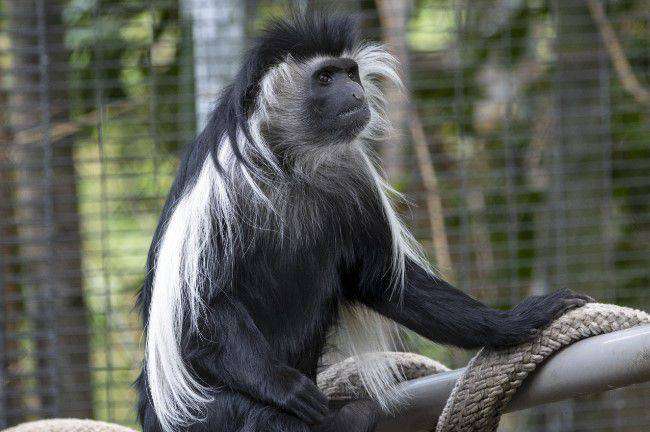
| Scientific Name | Colobus spp. |
| Size | 18-35 inches |
| Fur Color | Black and white |
| Life Span | Up to 30 years |
| Location | Africa |
| Diet | Leaves, fruit, and flowers |
The central and eastern African forest is home to various exciting and unusual primates, including the Colobus monkey.
The long, black-and-white fur sets them apart from other primate species in the area. The nose length varies with its species, generally between 2-3 cm and sometimes up to 5 cm.
The monkey’s large, jutting nose serves as a means of expression and communication during courtship and territorial disputes.
5) Guenon Monkey

| Scientific Name | Cercopithecus spp. |
| Size | 14-26 inches |
| Fur Color | Varies by species |
| Life Span | Up to 25 years |
| Location | Central Africa |
| Diet | Fruits, seeds, insects, and small animals |
The Guenon monkey lives in the forests of sub-Saharan Africa. It is a small, agile, and brightly colored Old World monkey. The nose length varies with its species, generally between 2-3 cm.
The nose of these primates is especially noticeable because it is more extensive and darker than the noses of other monkey species. The Guenon monkey’s giant nostril serves multiple functions.
4) Saki Monkey
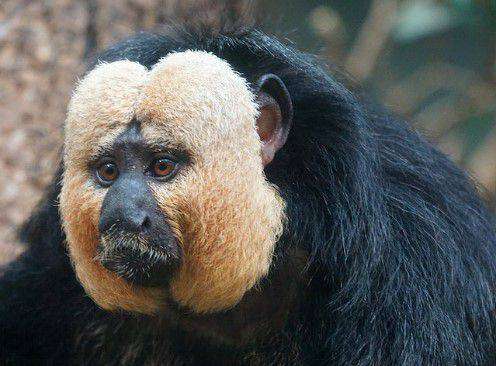
| Scientific Name | Pithecia spp. |
| Size | 12-18 inches |
| Fur Color | Varies by species |
| Life Span | Up to 20 years |
| Location | South America |
| Diet | Fruits, seeds, and insects |
Hector Hugh Munro, better known by his pen name Saki, was a British author best known for his bitingly satirical short stories. The Nose length varies with its different species between 1.5-3 cm.
Saki, born in 1870, was known for making fun of the upper classes and their ridiculous social norms. Saki was renowned not only for his literary abilities but also for his large nose.
3) Drill Monkey

| Scientific Name | Mandrillus leucophaeus |
| Size | 28 inches |
| Fur Color | Brown With Yellow Tinge |
| Life Span | 46 years |
| Location | Nigeria and Southwestern Cameroon |
| Diet | Fruits, herbs, seeds, insects, and small animals |
Drills (Mandrillus leucophaeus) are closely related to baboons and even more closely to mandrills; both are primates in the family Cercopithecidae (Old World monkeys).
The drill is a little monkey (70 cm/28 in) that resembles the mandrill but lacks that species’ distinctive blue and red facial markings.
There is significant weight heterosis in this species, with males reaching up to 20 kg (44 lb) and females reaching up to 12.5 kg (26 lb) (28 lb). The Nose length for males is 8 cm, and for females is a bit smaller than 4 cm.
The entire body is a murky shade of brown. At maturity, a man’s bottom lip is pink, his chin is white, his face is dark grey or black, and his nose has elevated grooves. Pink, mauve, and blue make up the behind. Drill operators will not find a pink chin on a female drill.
2) Mandrill Monkey
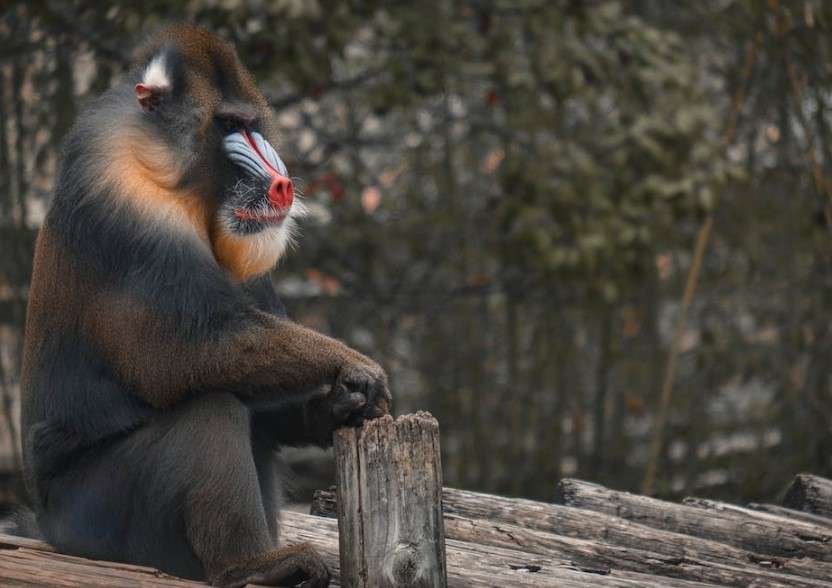
| Scientific Name | Mandrillus sphinx |
| Size | 23-35 inches |
| Fur Color | Olive green, dark brown, and black |
| Life Span | Up to 30 years |
| Location | Central Africa |
| Diet | Fruits, seeds, insects, and small animals |
Commonly known as “mandrills,” mandrill monkeys are an Old World monkey species found in the rain forests of equatorial Africa.
They’re the heaviest monkeys ever discovered, with a maximum weight of 120 pounds! They have an enormous canine tooth, which is 6 cm long, and the Males have a nose length of 8-10 cm, and Females have 2-3 cm.
Their big, brightly colored nose is another identifying feature. To communicate with one another, mandrills use bright blue and red coloration on their muzzles.
1) Proboscis Monkey
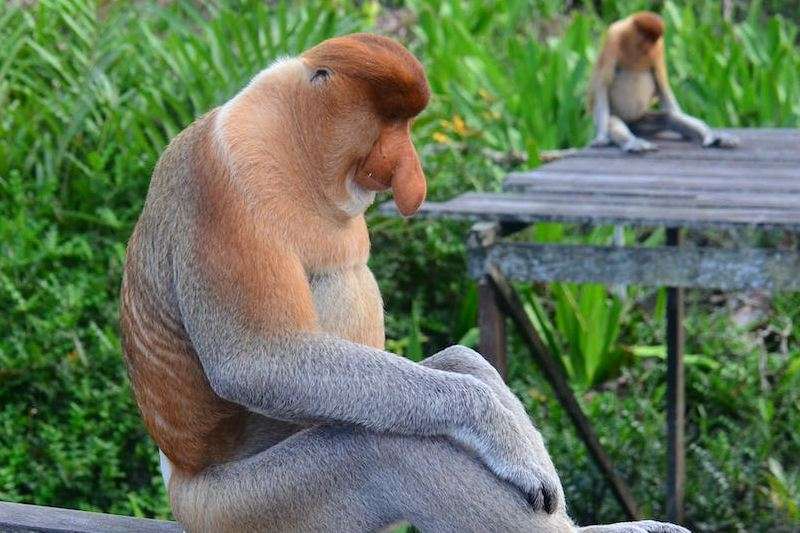
| Scientific Name | Nasalis larvatus |
| Size | 24-30 inch |
| Fur Color | Brown, grey, and white |
| Life Span | Up to 20 years |
| Location | Indonesia, Malaysia, and Brunei |
| Diet | Fruits, insects, and small vertebrates |
The Proboscis monkey (Nasalis larvatus) is a unique and fascinating primate found only on the island of Borneo in Southeast Asia.
What sets this monkey apart is its large and distinctive nose, which can grow up to seven inches long in males, and serves as a resonating chamber for their loud vocalizations. The Nose length is generally 10.2 cm.
The Proboscis monkey is a strong swimmer and is often found near bodies of water such as rivers, mangroves, and swamps.
They have webbed feet that help them swim and dive underwater for up to 30 seconds to escape predators and find food. They are primarily herbivores, feeding on leaves, fruits, and seeds but occasionally eating insects and small animals.
Conclusion
We hope you enjoyed this article about monkeys with big noses on Earth. While they may also look different, they all have one thing in common: their long, pendulous noses. These noses are used for communication and courtship and are essential to identifying other species.
Also Read:
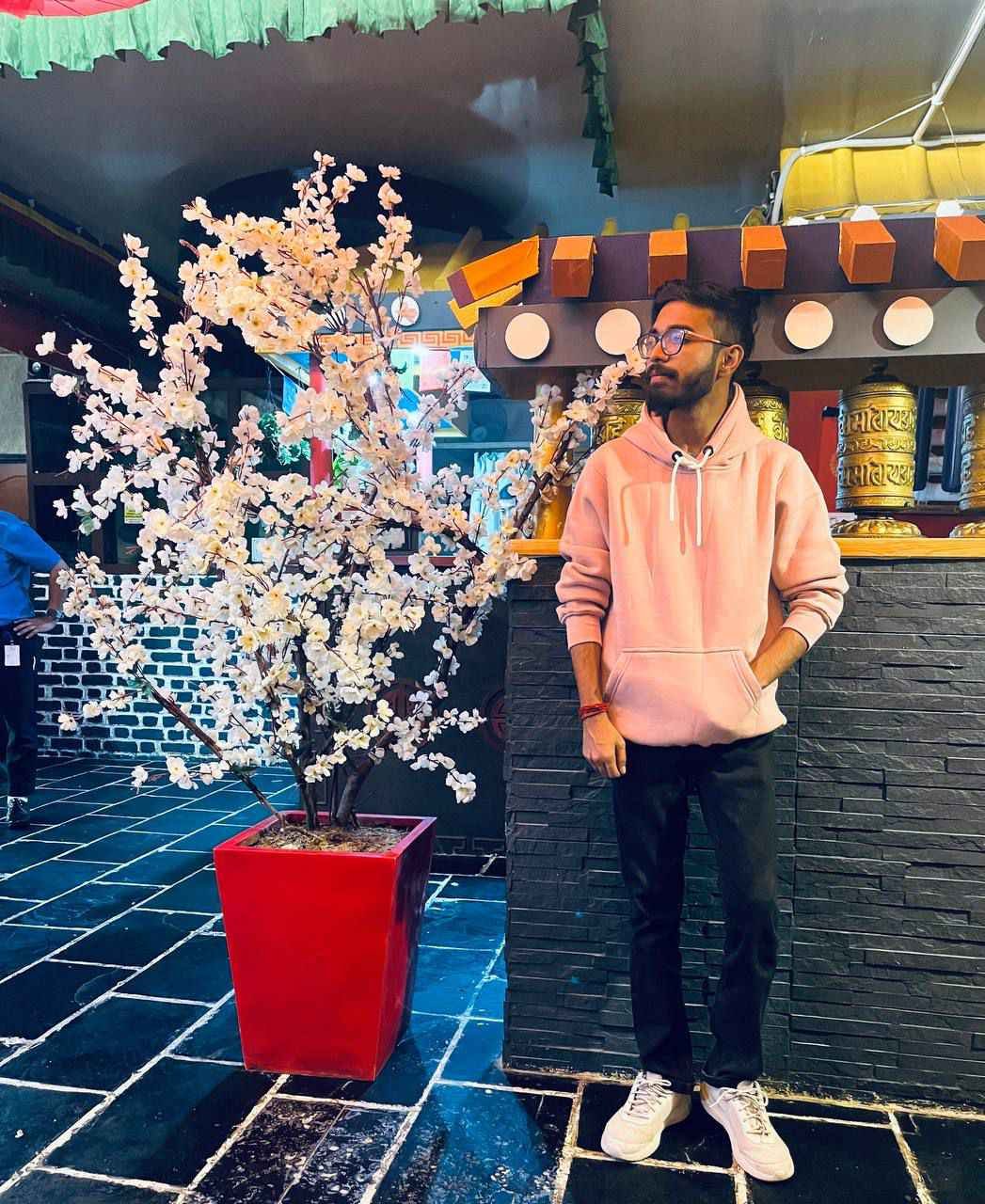
A writer who studied agriculture. Nature has always drawn me in, and my main goal in writing about it is to discover some of its secrets. You can usually find me reading Bengali and English masterpieces or filling the room with lovely music if I’m not engrossed in nature or anime material. I adore playing the guitar. I’m also that friend of yours who enjoys playing video games.
